 |
sabava silk | x 1 |  |
| Total Items: | 0 |
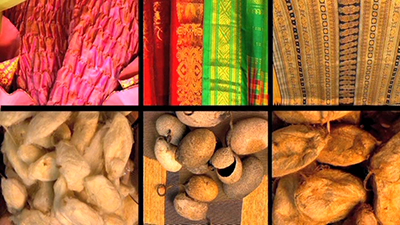
Silk has been intermingled with the life and culture of the Indians. Though India is producing all the varieties of silk i.e., dress materials, scarves/stoles, readymade garments, etc., the silk sarees are unique.
The saree is almost synonymous with the word silk. It is the traditional costume of Indian woman since time immemorial. There are innumerable references in Indian literature about this draped garment and the style of wearing differs from time to time, region to region and people to people. The silk sarees of India are among the living examples of the excellent craftsmanship of the weavers of the country.
India produces four varieties of silk produced, viz. Mulberry, Eri, Tasar and Muga.
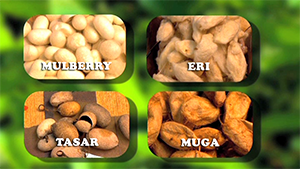
Silk is an animal protein fiber produced by certain insects to build their cocoons and webs.
The protein fiber of silk is composed mainly of fibroin and is produced by certain insect larvae to form cocoons.[1] The best-known silk is obtained from the cocoons of the larvae of the mulberry silkworm Bombyx mori reared in captivity (sericulture). The shimmering appearance of silk is due to the triangular prism-like structure of the silk fibre, which allows silk cloth to refract incoming light at different angles, thus producing different colors.
Many different types of silk are produced by a huge variety of different types of insects other than moth caterpillars. Yet none of these have been exploited for commercial purposes, though there has been basic research into the structures of such silks. Silk is most commonly produced by larvae, and thus largely limited to insects with complete metamorphosis.
Silk production is especially common in the Hymenoptera (bees, wasps, and ants), and is sometimes used in nest construction. Other types of arthropod produce silk, most notably various arachnids such as spiders.
The commercial process of silk making is highly complex and labor intensive. The following will provide basic information on how silk is made.
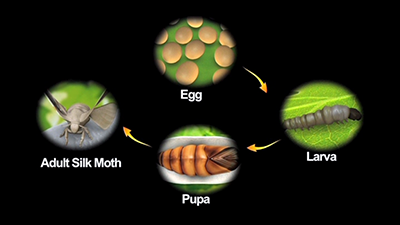
The total Life-Cycle of a Silkworm ranges from 6-8 weeks. Generally, the warmer the weather the quicker the Silkworm will complete its life-cycle, however, other factors such as humidity and exposure to sunlight are also very important. Ideally, Silkworms will experience 12 hours of sunlight, and 12 hours of darkness per day, a temperature of 23-28 degrees Celsius, as well as humidity levels of 85-90%. Under these conditions, your eggs should hatch in a period of 7-10 days.
| Eggs | 10-25 days |
| Lava and worms | 20-33 days |
| Pupa | 10-14 days |
| Moth | 5-10 days |
There are four stages in the life cycle of the moth which are as follows:
1. The egg which develops into a larva or caterpillar - the silkworm.
2. The silkworm , which spins its cocoon for protection , to permit the development into pupa.
3. The Pupa emerges from the cocoon as the moth.
4. Female moth lays eggs , so continuing the life cycle.
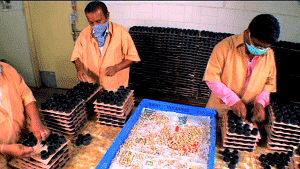
Cultivation of the silkworm is known as sericulture. Although many insects produce silk, only the filament produced by Bombyx mori, the mulberry silk moth and a few others in the same genus, is used by the commercial silk industry.
[The “silkworm” is, technically, not a worm but a moth pupa. For the sake of simplicity and consistency, however, we will use the term silkworm throughout this writing.]
Sericulture involves rearing of silkworms for the production of raw silk, which is the yarn obtained out of cocoons spun by certain species of insects. The major activities of sericulture comprises of food-plant cultivation to feed the silkworms which spin silk cocoons and reeling the cocoons for unwinding the silk filament for value added benefits such as processing and weaving.
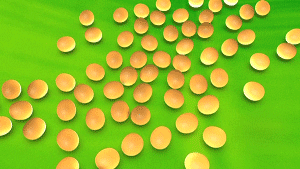
The first stage of silk production is the laying of silkworm eggs, in a controlled environment such as an aluminum box, which are then examined to ensure they are free from disease. The female deposits 300 to 400 eggs at a time.
In an area the size of your monitor screen, 100 moths would deposit some 40,000 eggs, each about the size of a pinhead. The female dies almost immediately after depositing the eggs and the male lives only a short time after. The adult possesses rudimentary mouthparts and does not eat during the short period of its mature existence.
The tiny eggs of the silkworm moth are incubated (about 10 days) until they hatch into larvae (caterpillars). At this point, the larva is about a quarter of an inch long.

Once hatched, the larvae are placed under a fine layer of gauze and fed huge amounts of chopped mulberry leaves during which time they shed their skin four times. The larvae may also feed on Osage orange or lettuce. Larvae fed on mulberry leaves produce the very finest silk. The larva will eat 50,000 times its initial weight in plant material.
For about six weeks the silkworm eats almost continually. After growing to its maximum size of about 3 inches at around 6 weeks, it stops eating, changes color, and is about 10,000 times heavier than when it hatched.
At this stage the interest in the food ceases and is ready to spin its cocoon.The silkworm begins to secrete a protein like substance through a small opening under the caterpillar's jaws which is called as the spinneret.The silk solidifies when it comes in contact with air.

The silkworm attaches itself to a compartmented frame, twig, tree or shrub in a rearing house to spin a silk cocoon over a 3 to 8 day period. This period is termed pupating.
Silkworms possess a pair of specially modified salivary glands called sericteries, which are used for the production of fibroin – a clear, viscous, proteinaceous fluid that is forced through openings called spinnerets on the mouthpart of the larva.
Liquid secretions from the two large glands in the insect emerge from the spinneret, a single exit tube in the head. The diameter of the spinneret determines the thickness of the silk thread, which is produced as a long, continuous filament. The secretions harden on exposure to the air and form twin filaments composed of fibroin, a protein material. A second pair of glands secretes a gummy binding fluid called sericin which bonds the two filaments together.
Steadily over the next four days, the silkworm rotates its body in a figure-8 movement some 300,000 times, constructing a cocoon and producing about a kilometer of silk filament.
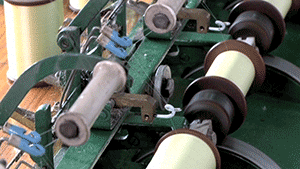
At this stage, the cocoon is treated with hot air, steam, or boiling water. The silk is then unbound from the cocoon by softening the sericin and then delicately and carefully unwinding, or 'reeling' the filaments from 4 - 8 cocoons at once, sometimes with a slight twist, to create a single strand.
As the sericin protects the silk fiber during processing, this is often left in until the yarn or even woven fabric stage. Raw silk is silk that still contains sericin. Once this is washed out (in soap and boiling water), the fabric is left soft, lustrous, and up to 30% lighter. The amount of usable silk in each cocoon is small, and about 2500 silkworms are required to produce a pound of raw silk.
Raw silk is twisted into a strand sufficiently strong for weaving or knitting. This process of creating the silk yarn is called “throwing,” and prevents the thread from splitting into its constituent fibers.
Four different types of silk thread may be produced from this procedure: crepe, tram, thrown singles, and organzine. Crepe is made by twisting individual threads of raw silk, doubling two or more of these together, and then twisting them again. Tram is made by twisting two or more threads in only one direction. Thrown singles are individual threads that are twisted in only one direction. Organzine is a thread made by giving the raw silk a preliminary twist in one direction and then twisting two of these threads together in the opposite direction.
In general, organzine thread is used for the warp threads of materials, tram threads for the weft or filling, crepe thread for weaving crinkly fabrics and a single thread for sheer fabrics.
Broken or waste filaments and damaged cocoons are retained, treated to remove the sericin, and combed. This is then processed into yarn, marketed as spun silk, which is inferior in character to the reeled product and much cheaper.